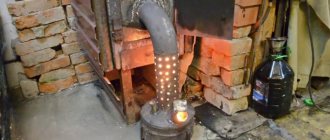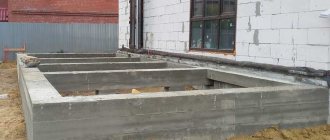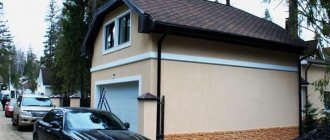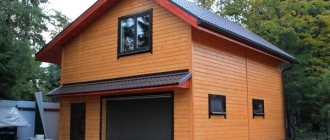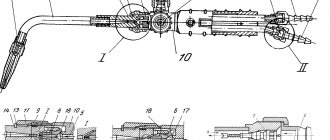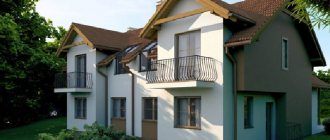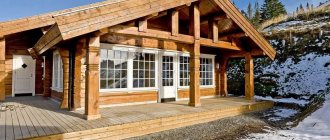Using the same methods as with the main structure of the cottage, it is necessary to correctly select a high-quality, durable and ultra-reliable foundation for the garage. The base of the structure will absorb not only the load from the car, but also absorb part of the pressure from the entire cottage. choose the right foundation for a house with a garage . Do not neglect the help of InnovaStroy architects, who have many years of experience in constructing a variety of modern country houses and cottages.
Features of the garage location
There are several requirements that are recommended to be taken into account when constructing a garage near the house:
- The entrance gate to the site will determine which side of the house the garage will have to be built (on the left or on the right). Because the main requirement is the shortest path from the gate to the site to the gate to the garage.
- Ideally, if the garage will be built during the construction of a country house. That is, one common foundation is laid under both buildings, one load-bearing wall will separate them, optimally if both parts of a single building structure are covered by a common roof.
- If the garage attached to the house is a free-standing , then it can be raised taking into account your own design. There are two design options: the garage box is solid, that is, four load-bearing walls, or three walls of the structure are attached to the wall of the main house.
- The garage design must have a gate and a wicket , as well as a door connecting it to the house. This must be taken into account in the design of buildings. A vestibule must be installed in front of the door or inside the house, or inside the garage, which will protect the house from the aggressive operating conditions of the garage.
- The roof of the house and garage are covered with the same roofing material .
The garage and the house must be covered with the same roofing material Source stroyportal.ru
The project must also take into account other requirements regarding the rules and regulations for the operation of the garage premises:
- the distance from the window or front door of the main house to the garage wall is at least 2.5 m ;
- the distance from the balcony of the house or the windows of the second floor to the ridge of the garage roof structure is at least 2 m ;
- if the garage will be used for motorcycles or mopeds, then both of the above parameters increase to 5 m .
Since the garage is a fire-hazardous structure, it must be built from non-combustible materials. A fire alarm, fire extinguisher and other required tools and devices related to fire-fighting equipment are installed inside.
Combination of garage and outbuildings
A garage, as a rule, is used not only for a car, but also serves as a storage place for various things that are simply not possible to store at home. As an alternative, a project of a combined garage with a utility block is proposed. Moreover, each room will be used strictly for its intended purpose, will not take up a large area of the site and will cost less than separate construction.
The garage can be combined with different buildings, for example, a bathhouse or a barn
In addition to practicality and ease of use, one can highlight the aesthetics of the future structure. You can get an outwardly attractive design by adhering to a single style, using the same materials for the construction of walls and roofs. The disadvantage is the risk of fire and rapid spread of flame.
The garage can be combined with an outbuilding
How to calculate the size of a building
The initial tasks before the construction of combined premises are determining their size and creating a project. To calculate the dimensions as accurately as possible, consider some nuances.
- A garage is a spacious room where the owner can stay comfortably and carry out repair work. Do not overdo it with its size, because huge areas will not provide a cozy atmosphere.
- Solving the issue of heating requires additional financial costs.
- Limiting the area of the site involves choosing the optimal thickness of the foundation and load-bearing walls of the structure. Since the thermal insulation of the room directly depends on the thickness of the walls, in this case you should not save.
Depending on what will be stored in the utility room, markings for communications, window openings, shelving and other additional equipment are planned. The area of the garage box is determined by the number of cars. You can build a room for two or more cars.
Utility units can be of any size, which is determined only by the purpose of the room and the dimensions of the things stored in it.
What materials can you build a utility block from?
Developers give preference to brick, wood, concrete and frame structures. It is important to familiarize yourself with the characteristics of the materials in advance.
- Brick is the most popular material, which guarantees the durability of the future structure, the reliability of its walls and a presentable appearance. Among the disadvantages are the duration and high cost of construction.
Brick is an excellent material that retains heat - Wood is the best option if the utility block will be built near the house from the same material. Timber and boards are safe for people and are in demand due to their affordable cost and stylish appearance. A wooden frame does not require laying a foundation, and to maintain warmth and dryness in a garage with a utility unit during the cold season, it is enough to install a medium-power heater. The main disadvantage is the high risk of fire. In the presence of flammable liquids, of which there are always plenty in the garage, dry wood can burst into flames at the slightest malfunction.
Wood is rarely used for garage construction - Concrete is the cheapest and most accessible material. But the appearance of the structure made from it is significantly inferior to its analogues. Such a frame is installed with a foundation.
A combined garage with a concrete shed will last a very long time - Frame structures make it possible to erect a building within a few days, but in unfavorable climate conditions this option is simply not practical.
Owners of private houses use metal structures, laminated veneer lumber, panel sheets and other materials as the basis for a garage with a utility block. To connect the rooms, passages are installed inside, the doors of which can be made of glass or plastic.
Video: construction of a frame garage-shed
Projects of a house with an attached garage
In principle, there are two main design options for houses with an attached garage: the garage is built on one or two floors. Today, two-story buildings are very popular because several rooms appear above the car storage area that can be used in different ways. For example, an office, a greenhouse, a winter garden, a billiard room, etc. The only thing that is not recommended to be installed above the garage is a living room.
In this case, the second floor can be built as a full floor, or in the form of an attic part of the building. Regardless of this, the premises on the second floor are fully exploited.
Garage attached to a two-story house with an attic superstructure Source yandex.ru
Criterias of choice
If you need to save space on your site, you can build a garage above the basement.
Basic recommendations for choosing:
- If you need to save every ten meters, a built-in basement garage is the best solution.
- The larger the vehicle, the less suitable it is for storage within the home. If the owner of the dacha drives a minibus, it is better to build a separate box.
- If the premises are also used as a car repair shop, choose a free-standing structure or at least an attached one. Otherwise, the costs of sound insulation will be enormous.
- If the house is used only in the warm season, a canopy is built.
The design of the garage - detached, carport, attached - is chosen taking into account many factors. Any solution has pros and cons, but it is important to choose the optimal one for specific conditions.
Technology for constructing an attached garage
When considering the question of how to attach a garage to a house, one must begin with whether the house has already been built or is in the construction plan. We will consider the two positions separately. And let's start with a newly constructed facility that is being built from scratch.
The house and garage are being built together
This is the most convenient option in terms of construction. There is no need to think through methods for connecting the garage structure to the structure of the main house. There is a project here in which both parts of the future building are fully connected. This applies to the foundation, walls, and roof.
Therefore, the technology for constructing an object of this type includes:
- construction of a common foundation :
- construction of walls :
- installation of floors :
- installation of roof structure;
- general facade decoration .
General facade finishing Source techno-holding.ru
It is necessary to immediately stipulate that the foundation for the building is calculated based on the mass of the main house, regardless of how many floors it will rise. That is, if the house is built on three floors and the garage on one, then the same foundation will be laid for both of them in terms of size and shape.
The parameters of the foundation structure should not be allowed to be changed under the garage. Different cross-sections and different masses will lead to parts breaking apart. And the reason will be the shrinkage of two parts of the building, which have different masses. Plus, seasonal ground fluctuations are added here, especially in the first two years after construction. This will immediately become noticeable when a large crack appears on the facade. It’s impossible to get rid of it, unless it’s a ventilated façade.
A garage is attached to the existing house
The biggest difficulty with this option is to correctly connect the foundation of the extension to the foundation of the main building. The thing is that the house has already gone through the process of shrinking, and the garage will only shrink. Displacement may occur at their joints, which will lead to the formation of cracks. But this is a minor nuisance. Often there is a misalignment of two connected buildings, and these are not just cracks, this is a violation of the integrity of both the garage and the house.
Crack between attached garage and house Source pol-master.com
See also: Catalog of garage projects presented at the Low-Rise Country exhibition.
Therefore, it is important to make the connection using specially developed technologies. The first of them is a rigid connection of two foundation structures.
The base for the garage is installed at the level of the foundation of the house. That is, they dig trenches that are filled with a sand and gravel cushion. A reinforcing frame is installed, filled with concrete mortar. But it is necessary to try to tie the new structure to the old reinforcement. To do this, pins from reinforcing bars are driven into the old foundation, the length of which varies between 30-50 cm. This is not so easy to do, so they use a hammer drill with a drill, the diameter of which should be slightly smaller than the diameter of the driven reinforcement. That is, the pin must fit into the concrete “with tension.”
Next, the pins are tied with wire to the reinforcing frame of the sole under the garage. And only then the concrete solution is poured.
What materials should you prefer?
Choosing a material for building a garage with your own hands is a serious topic that requires an integrated approach. It is necessary to determine, based on the assigned tasks, the priority property:
- Reliability of the design.
- Speed of construction
- Low cost, simple construction process.
The strongest and most durable is a brick extension. The use of metal will reduce construction time, but a building susceptible to corrosion will not last long. The use of cellular concrete blocks will significantly speed up the construction process; the only difficulty is the need to finish the block surfaces from the outside and inside.
The adjoining wall must meet the requirements of fire safety standards. The adjoining wall must meet the requirements of fire safety standards.
Video description
The video shows one of the options for attaching a new extension foundation to the base of the main house:
Additionally, you can strengthen the structure of the new foundation if you make it combined. For example, if a strip modification is being laid, then reinforced concrete piles must be poured from the foundation of the main house in the place where the garage foundation is poured at a distance of 1.5-2.0 m. This is done like this:
- Dig trenches for a strip-type foundation structure.
- In the required location, a drill (electric or manual) is used to create wells with a depth below the soil freezing level.
- cushion 10 cm thick is poured into them
- A reinforcing frame is inserted from three structures connected into a triangular cross-section.
- Concrete is poured .
The piles must protrude to a height of at least half of the strip structure. Therefore, pipes (metal or plastic) are installed above the ground for them. As soon as the piles gain concrete strength, they proceed to forming a strip foundation structure for the garage. Such pile pillars will act as a brake if two strip foundations, under the influence of various forces and loads, begin to move apart in opposite directions.
Strip foundation with reinforced concrete piles built into it Source pobudova.in.ua
The foundation is the key to the longevity of the garage
Russia is a big country. There are rocky, clayey and sandy soils here. In the first case, they do without a solid foundation. The earth will absorb and redistribute the load from the car. In all other situations, you will have to spend time and effort on arranging the foundation.
On quicksand, preference is given to the pile, columnar or pile-screw option. A strip foundation is acceptable regardless of the type of soil. In any case, the work can be done with your own hands, without involving a team of professional builders.
Materials for constructing a garage
Since the topic of the article refers to a brick house, this does not mean that the garage should be built from this building material. Here you can use various wall materials, because the main task is to correctly build the extension and correctly attach it to the structure of the house.
A garage made of foam blocks attached to a brick house Source 9dach.ru
With block materials it is more or less clear. You just need to indicate that when assembling garage walls from them, you must definitely attach them to the wall of the house. For this purpose, reinforcement with a diameter of 10 mm is used, from which the pins are made. They are simply driven with a hammer into the wall of the house at the level of the masonry joint. If the garage is built of brick, then the pins are driven in every 6-10 rows, if made of blocks, then every 3-5 rows. At each level, 2-3 pins are driven in. The main task is that they are laid in the seam. In this case, the length of the protruding part of the pins is 25-30 cm.
If you need to attach a garage made of timber to your house, then to attach a wooden wall to a brick wall you will need metal fasteners in the form of perforated corners, anchors and long wood screws.
Each laid beam must be attached to a brick wall as follows:
- a corner between them so that its shelves tightly adjoin the two structures;
- make marks on the brick plane for anchors ;
- the corner is set aside, holes are made using a puncher according to the marked marks, into which the main part of the anchors ;
- put the corner in place, fasten it to the brick wall with screws from the anchors;
- Fastening to wooden beams is done with long self-tapping screws .
Timber garage frame attached to a brick house Source pinterest.com
Important: registration of redevelopment
A private house is private property. But at the same time, the owner is obliged to register all newly built objects or register alterations. Before construction begins, BTI provides:
- a copy of the certificate confirming ownership of the property;
- a copy of the floor plan of the building;
- construction project. It is better to contact a specialized company and order;
- technical passport of the main building;
- design documentation previously approved by the local architectural department.
All documents are copied and notarized.
If this is not done, then an unfriendly neighbor or any overly active passerby will decide that the building is located incorrectly and violates his rights to receive sunlight. In this case, you will either have to demolish everything, or pay a significant fine and register officially.
Roof of attached garage
The roof of a garage attached to a house is assembled in two ways: as a single whole together with the roof of the house, or as a separate part adjoining the wall. In the first case, a single rafter system is assembled, covered with one roofing material. In the second case, the rafter system of the garage roof rests against the wall of the house. Let's look at this option in more detail.
Garage and house under one roof Source xianweizhu.com
General recommendations for the process
When adding a garage to a residential building, you should follow a number of recommendations.
Extension plan for the cottage.
This will help simplify the construction process and optimize it as much as possible:
- Immediately after completing the foundation, it is strictly forbidden to start building walls. It takes time for the foundation to settle. Sometimes this takes about a year. If for a long time the foundation maintains its integrity and does not shift, then you can begin to build walls.
- In the process of adding a garage to a residential building, difficulties may arise due to the different heights of the roof of the extension and the house. In this case, precipitation will fall from the roof of a residential building onto the roof of an attached structure. To avoid this, during the construction stage, the roof joints of both buildings are waterproofed.
- The roof of the extension should be made at a greater slope than the roof of the house. This will speed up the removal of sediment. Also, at the junction area it is worth fixing a corner made of galvanized material, 30 cm of which is located directly under the roof. Thanks to it, it will be possible to prevent leakage of the roofing covering.
- The extension should be in harmony with the residential building, so it should be built in the same architectural style as the house itself. Finishing work is carried out according to the same principle, and they try to organize it in a way that is as identical in design as the main building.
- The premises of the attached garage can be used not only for its intended purpose. For example, you can organize a recreation area on the roof.
Advantages and disadvantages of an attached garage
A house with an attached garage actually has many advantages:
- communications have already been installed in the house , which can be easily and quickly transferred to the garage;
- the load-bearing wall of the main building is thick, which means with minimal heat loss;
- You can organize the entrance to the house through the garage, arranging it beautifully.
As for the shortcomings, there is only one - the usable territory of the suburban area is reduced, part of which will go under the access road. If the garage was built as a separate building, then it could be built at the edge of the site with a gate opening outside the dacha area. And this is an increase in the free area of land that can be used for other needs.
GARAGE IN BASEMENT
For areas with a pronounced difference in heights, it is advisable to use a space-planning solution for a house with offset levels (Diagram 5). In this case, the garage is located in the technical area at the ground floor level (basement). The location of the garage below ground level entails more stringent requirements for waterproofing and water drainage. Due to the likelihood of icing on the ramp to the garage, it is advisable to install a ramp heating system.
Project Mokka (283 sq.m.)
A built-in garage for 1 car is located in the basement. In this case, one of the architectural solutions is to conditionally divide the house into 2 parts and their location relative to each other is not strictly horizontal, but with a slight offset in floor level. This determines a certain linkage of staircase landings along the levels between the first and second floors.
For the types of garages in question, the following rules apply:
- In the case of using the space above the garage, the ceiling (and in the built-in version, walls common with other rooms) must ensure tightness and sound insulation;
- To reduce the risk of car corrosion associated with high humidity, it is recommended to install waterproofing and forced supply and exhaust ventilation. It is also necessary to provide a drainage system with a washbasin and a drain grate for water drainage;
- In the case of constructing a “cold” garage, it is necessary to insulate the main wall separating the garage and the main premises;
- It is recommended to equip the garage as a technical room with a fire safety system.
Advantages of an extension
Sheds can be of different sizes: from a small shelter for 1 car space to structures made entirely around the garage. Some people simply make a canopy in front of the gate.
In any case, such a shelter will bring many benefits to the owner.
Here are just some of the advantages:
- A canopy in front of the garage will protect you from bad weather and precipitation. You won’t have to spend a lot of time clearing the roadway near the gate if it snowed the day before.
- Under the canopy you can carry out minor car repairs if the garage itself is cluttered, and there will be much more space around.
- Sometimes you can just have a nice time under a canopy. Set up a table, invite friends and sit without fear of bad weather.
The construction takes 1-2 days, and you can even bring the materials in your own car.
Installation of load-bearing structures of the canopy
Before installing the canopy, the strength of the entire structure must be calculated. It is important to make the extension so that the garage door can open easily. Before installation begins, the construction site is prepared. Excess trash is removed. They cut down the grass that interferes with construction.
When the place is ready, the dimensions of the future canopy are measured. After this, you can begin to dig holes for the posts on which the rafter system under the canopy will be attached. The frequency of digging holes for the posts directly depends on the weight of the roof. If it is made of heavy materials such as slate, then the distance between the holes is no more than 80 cm.
When using lighter roofing material (polycarbonate or soft roofing), the distance can be maintained within 1.2-1.5 m.
The pillars must be dug to a depth of more than 1 m. To increase the service life of the structure and prevent its collapse, the pillars must be coated with waterproofing. These can be either special chemicals or simple bitumen. The poles themselves are made of timber (10-18 cm), metal pieces of pipes or angles at least 3 m long.
The supports should be leveled. It is better to start installation from the wall closest to the garage. First, one support is installed vertically on the right side of the garage. Access to the garage is checked again. It is important that there is enough space left for the garage door and its opening. When the level is set, the post is compacted in the hole using stones. This must be done carefully so as not to knock the level down. When the post is securely fixed, it is filled with cement solution and allowed to dry for about 2 hours.
This sequence of setting and digging is applicable for all the following support pillars.
Two pillars are level. Now you can set up two more extreme pillars located near the road. They should also be installed level. Only they are not positioned relative to each other, but along the sides on which the installation is carried out. That is, the rightmost pole, which is located near the road, is placed along the right support to the garage, the left one is similar, only on the other side.
After setting 4 starting posts, a thread is pulled between the two supports on each side. It will help you level the remaining pillars.
When they are all installed, they are measured again with a level. It is better to tie the spans between the supports on one side crosswise using boards or use welding if they are made of metal. At the top, each pair (left and symmetrically located right post) is tied with a board or welded with a long corner.
Rafter system and roofing
The design of the rafter system directly depends on the roofing material. If the canopy is planned to be made of cellular polycarbonate, then you can get by by simply installing a board under the ridge. It is not recommended to place it too high. With a greater rounding of the roof, the stress in the material will increase. This is fraught with microcracks and loss of rigidity. The carbonate is fixed in three places - on the ridge and on both sides to the supports. For fastening it is best to use special roofing bolts. They will not leak in rainy weather and will not crumble the material during installation.
When installing a heavier roof (slate or corrugated sheeting), it is necessary to make a more reliable rafter system. The rafters are tied to the ridge and a simple lathing is made. After this, the roofing material is laid.
We make a decision on the choice of gate
Adding a garage to your home, equipped with a secure gate, will ensure the safety of your vehicle. The choice of gate design depends on the financial capabilities and preferences of the owner of the premises.
The following types of gates are traditionally installed:
- sectional type structures;
- classic swing gates;
- roller shutter mechanisms.
A distinctive feature of sectional and roller shutter structures is the absence of the need for additional space for opening, the ability to remotely issue commands to provide access to the vehicle.
If you want to ensure a comfortable thermal regime in the garage and the absence of extraneous noise, take care of reliable thermal and sound insulation of the room, including the gate. Unobstructed vehicle entry is ensured by the required width of the structure, which fits harmoniously into the building.


